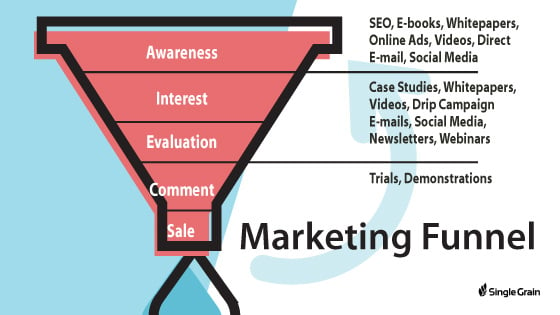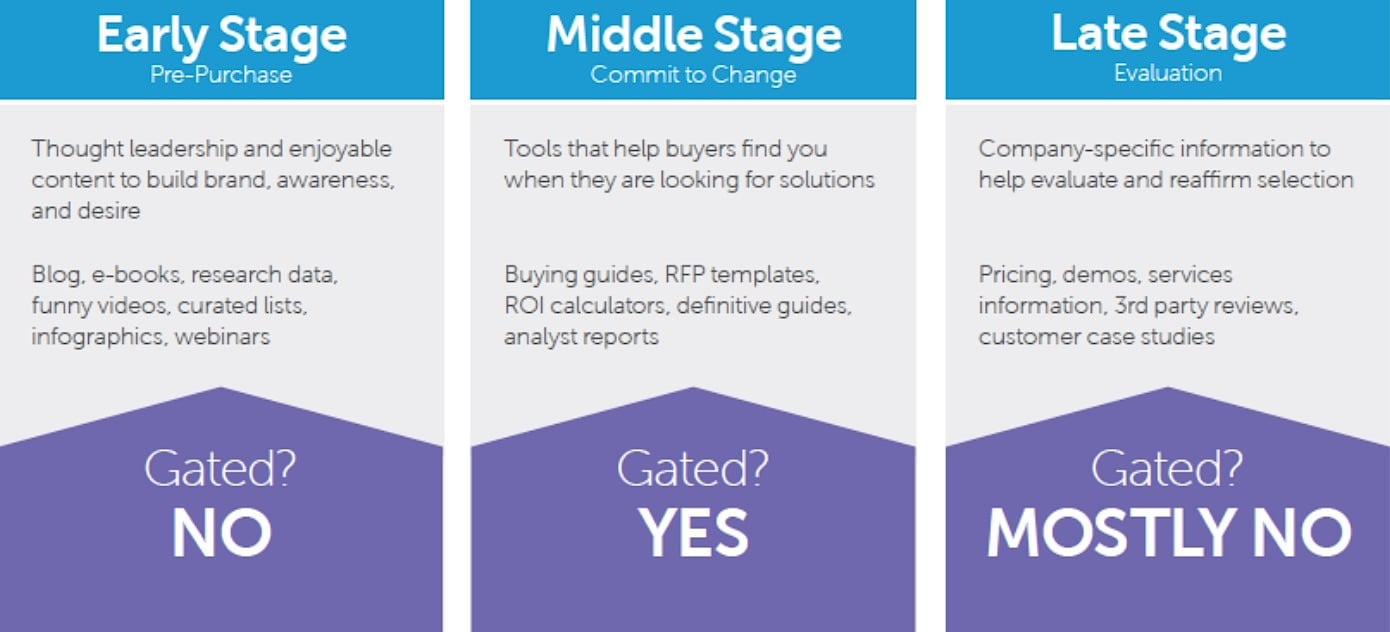The Marketer’s Guide to Content Marketing
[Free Consultation] Are you spending money on advertising but not getting the results you want? Are you looking for more sales and leads but have no idea where or how to start? Get help from our world-class marketing experts in a free consultation call.
Click Here To Schedule Your Free Consultation Now
We’ve all heard it before…“content is king.”
But what does that even mean? And where do you start if you hope to ascend the marketing throne?
Neil Patel defines content marketing as:
“…a long-term strategy, based on building a strong relationship with your target audience, by giving them high-quality content that is very relevant to them on a consistent basis.”
Content marketing allows you to be someone’s guide as they go through their decision-making process, which is key because buyers today go through as much as 90% of their purchase-decision process before ever engaging with a brand or its sales team.
In other words, by the time you’re attempting to sell to them, they’ve already developed strong opinions about many important decision factors. Wouldn’t you love to guide and influence those opinions?
With a strong content strategy, you can be their backseat driver as they tackle their challenges and learn what an ideal solution looks like. When it comes time to buy, they will already have established strong trust with you and your brand’s values.
Why Content Is King
Content was crowned king because it provides three mission-critical advantages to your marketing efforts that all contribute to the bottom line:
1) Increased Brand Awareness
As customers are searching for answers to their questions and solutions to their problems, they are more likely to discover your product via helpful content than by going directly to your website or e-commerce store.
Considering that 81% of consumers will conduct online research prior to making a purchase, having a strong and respected brand on the Internet is of utmost importance. But brand awareness does not just mean that people know your company’s name; it’s that they know your reputation, your values, and your personality. If shoppers know who you are, they’re more inclined to give you their hard-earned money.
And how do people grow to recognize your brand? Through all the valuable and free content that you are putting out there.
2) Stronger Customer Relationships and Loyalty
When customers view you as an authority on whatever subject you’re writing about (and knowledgable about, since that’s your niche), you will win their trust early which will make selling to them later on so much easier.
If your content provides value to readers (via expert information, answers to their questions, solutions to their problem), you will also develop a sense of reciprocity. This is what marketing rockstar and tech investor Gary Vaynerchuk talks about in his book “The Thank You Economy.”
3) Long-lasting, Low-cost Traffic, Leads and Sales
It’s true that content marketing isn’t the cheapest way to boost sales in the short-term. It can take months to start seeing the real ROI and it takes time and money up front to start generating free content.
But if it’s done well, the growth that good content, especially evergreen topics, generates will only compound:
A good content strategy grabs customers at every stage of their decision-making process and it may take a while for them to turn into paying customers. But this is actually a great thing as consumers spend an average of 79 days conducting online research before buying. The sooner you catch them in that process, the better your chances of closing the sale.
Some of the most successful companies in the world like Intel, IBM, and American Express all attribute their success to years of content marketing. But it’s not a strategy reserved for these enterprise companies, so let’s take a look at how you can develop your content marketing efforts on any budget.
Learn More: 5 Steps to Becoming an Expert Content Creator (According to Google’s Phantom Update)
Launching Your Content Strategy
The key to winning at content marketing is well-developed planning. Throwing up some random blog posts when you have time won’t do. You need to have a solid content strategy.
Step 1. Know Your Goal
Before you do anything else, outline what you hope to achieve with your content marketing. More leads? More sales? More e-mail subscribers?
How does it fit into your overall marketing and sales efforts? This part is very dependent on your business and objectives. There’s no single right answer, but HubSpot developed a nice free template to help you figure it out.
Step 2. Define Your Market
The next step is to know who your target market is, and a great way to know is to create buyer personas. As we said in our blog post on this subject, “Part of the reason marketers fail at persuading buyers is because they see their customers as data points, not as people.”
Defining your target audience means doing the research and creating a detailed description of your ideal customer as if he or she were a real person. Check out this “Tommy Technology” buyer persona:
Only when you know exactly who you’re selling to can you tailor your content, language and message to their particular needs.
If you need help, we put together this infographic that’s all about the science of building buyer personas.
Then head over to The Complete Guide to Developing and Using Buyer Personas.
Step 3. Map Out Your Typical Customer Journey
Once you know who your customers are, think about how they go from having a problem to finding a solution.
Most customers do this by moving through three key phases: awareness, interest, and evaluation.
During the first phase, customers become aware of the problem they have. They start to ask questions and do general, unguided Google searches. They may have noticed the problem themselves, or they realized it based on the content you generated. For example, maybe before this article, you didn’t realize that your business needed to have a content marketing strategy.
Once they’ve figured out what exactly their problem is, they then start to search for general solutions, and after they’ve clarified the solution that they need, they hunt for brands who have a product or service that fits this.
Describe the emotional state of your customers at each step in the process. What questions are they asking? What concerns do they have?
Learn More: How to Optimize Your Content Strategy with the Buyer’s Journey
Step 4. Develop Content Ideas
While you’re figuring out what questions customers are asking through their decision-making process, think of how you can create content that answers those questions and eases their concerns. Where can you step in and help them move toward the next phase in their process?
You should always focus on providing value to your customer by helping them learn or improve in some way. If it’s quality help they can’t find elsewhere, even better. One way to tackle this challenge is to ask yourself, “what is my business uniquely qualified to talk about?” That’s what Intel did to grow one of the leading IT blogs in the world.
You can type keywords and phrases into Google and see which questions other searchers are Googling and the results that come up. You can check out sites like Quora or Reddit to see what questions and subjects are popular. You can use tools like BuzzSumo or Feedly to do the same thing. Scour your social media pages, e-mail queries and customers service reps to discover what people are asking you.
If you’re still stuck after that, don’t fret – there are tons of tools and strategies to generate great content ideas.
Step 5. Select Your Medium
Many content marketers start out by writing a series of blog posts. That’s a really good option. It’s straight-forward and easy to self-produce or outsource.
But it’s not your only option. There are plenty of ways to create engaging content. Here are just a few:
- Blog posts
- E-books
- PDF templates & checklists
- Infographics
- Videos
- Podcasts
The most important consideration here should be what format would most appeal to your audience. Fitness companies, for example, do well by producing tons of video content. You may also want to consider what resources you have available. Starting a blog can be as easy as logging into WordPress and writing. Producing quality video content may require a bit more investment in time and money.
Finally, you’ll need to decide whether or not to gate your content. Gated content requires the reader to give you something, usually an e-mail address, in exchange for access to the content. It’s often embedded inside existing content as an incentive to subscribe. You’ve probably noticed examples of this all over the Single Grain blog. In fact, here’s one:
Gated content is great for collecting e-mails and pulling customers deeper into your funnel. But it also puts a barrier between the reader and your information. So you need a balance and should be strategic about when you use it.
Generally, you want to target gated content at customers in the middle “information” phase of their decision-making process as they’re getting ready to buy:
Learn More: How To Write Blog Posts that Actually Convert Readers into Customers
Step 6. Publish!
As you expand your content strategy, you’ll want to develop a detailed editorial calendar to plan out all your major themes and campaigns for the year and then break down specific content monthly and even weekly.
But if you’re starting out, you can go a little slower and just focus on the next 90 days. Take your best content ideas from step four and map them out across the next three months. This will help you publish in an organized fashion and craft a narrative over time.
Writing with a narrative or theme in mind helps subscribers use your information and encourages them to spend more time on your site reading each post.
Your post about how to choose the best home automation products should probably come after the one where you explain the benefits and uses of home automation. You can then link the content together so readers flow from one article to the next, and can go back if they missed one in the series.
You should also consider holidays and trends that are relevant to your market. Obvious examples are Black Friday or Valentines Day for e-commerce companies, but there might also be important, less obvious holidays for your niche.
If you’re working with a team of writers or marketers and want to use a centrally organized calendar, you can use CoSchedule, SmartSheet or even an Excel spreadsheet.
It’s important to publish in a consistent fashion so that your readers know what to expect. You’ll also want to publish frequently enough to stay at the top of your customer’s mind.
Related Content: How To Turn Your Editorial Calendar into a Well-Oiled Content Machine
Step 7. Promote Your Content
After your content is published, get the most out of it by promoting it to your audience. Make sure to let your subscribers know about new resources on social media or in a weekly newsletter.
But don’t stop there. Reach out to influencers and other brands in your space and share your blog post or infographic with them. If they think it would be valuable to their readers, they might share it on Twitter or link to it on their site – helping you reach a new audience.
Don’t be pushy or spammy, though. Make sure you share your content as a helpful resource and avoid flat out asking people for a retweet or backlink without a compelling reason. That won’t do much but earn you a bad reputation.
Step 8. Revisit and Leverage Content
As your content library grows, you can start to revisit old pieces and milk them for more value to really boost your ROI. By putting in a little extra work you can boost the search ranking of your existing content and help keep it relevant rather than constantly creating something new from scratch.
Here are a few ideas…
A) Expand Existing Content
Identify your most popular and useful blog posts and add an extra 1,000 words of content. Be sure to update sources, numbers, and trends to ensure giving it a boost in search ranking.
B) Create Downloadable Guides
Check Google Analytics and see which posts are attracting the most visitors to your site, then tidy up the formatting and turn it into a PDF download you can use a gated content upgrade.
C) Create an E-book
Similar to the idea above, take a series of posts and combine them to publish a comprehensive e-book on a topic you’ve already covered extensively!
You can even offer it on Amazon as a lead magnet to draw shoppers to your website.
D) Turn Written Content into Visual Content
Take one of your best blog posts and turn it into a video or infographic to boost its shareability and value.
If you don’t have someone on the team equipped to bring your words to life, consider heading over to Fiverr or Upwork and hire an animator or designer. Your existing content can easily serve as a blueprint for them, so you won’t have to worry about industry experience or explaining to them what you are hoping to create.
Learn More: 9 Ways to Repurpose Your Old Blog Content
Conclusion
Content marketing is full of possibilities and benefit for your business. That’s why an entire industry has evolved around it, with dedicated blogs, companies, and even top executive level positions.
But the important thing is that you get started. As you create content and receive feedback from readers, you’ll quickly refine your process.
It’s important to monitor results so you know what’s working and what’s not, but don’t expect too much for the first 3-4 months as your content starts gaining traction among readers and search engines.





